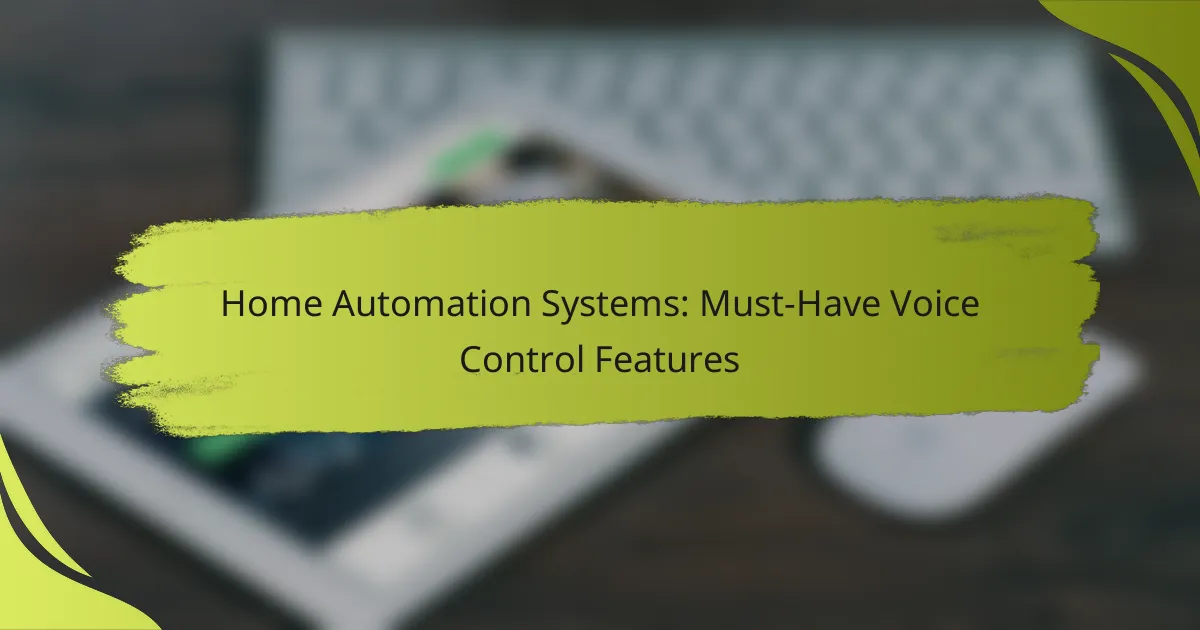Home automation systems have revolutionized the way we interact with our living spaces, and essential voice control features play a pivotal role in this transformation. Key functionalities such as smart speaker integration, multi-language support, and customizable voice commands enhance user experience and ensure effortless management of smart devices. By leveraging voice control, users can simplify their interactions and create a more intuitive home environment.
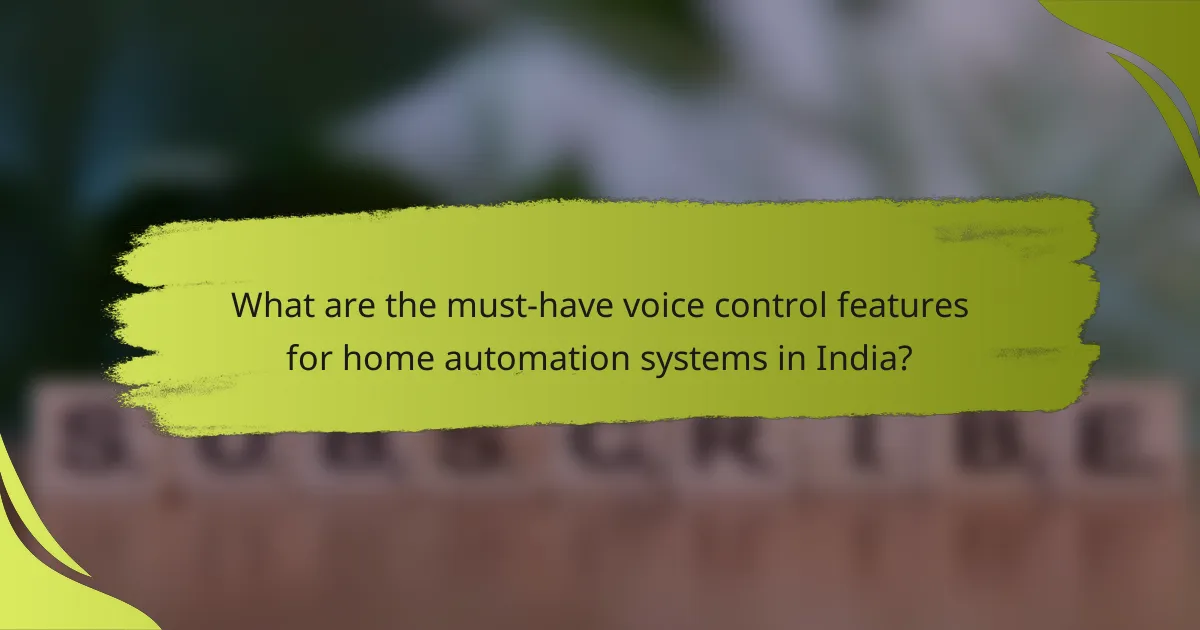
What are the must-have voice control features for home automation systems in India?
Essential voice control features for home automation systems in India include smart speaker integration, multi-language support, customizable voice commands, device compatibility, and voice recognition accuracy. These features enhance user experience and ensure seamless interaction with various smart home devices.
Smart speaker integration
Smart speaker integration is crucial for effective voice control in home automation. Popular devices like Amazon Echo and Google Nest allow users to control their smart home systems through simple voice commands. Ensure your automation system is compatible with these speakers to maximize functionality.
When selecting a smart speaker, consider its ecosystem. For instance, Amazon Alexa works well with a wide range of devices, while Google Assistant excels in search capabilities. Choose a speaker that aligns with your existing devices for optimal performance.
Multi-language support
Multi-language support is vital in a diverse country like India, where multiple languages are spoken. A good home automation system should recognize and respond to commands in several regional languages, enhancing accessibility for all users. Look for systems that offer support for languages such as Hindi, Tamil, and Bengali.
Check the language settings on your smart devices to ensure they can understand your preferred language. This feature not only makes the system more user-friendly but also increases the likelihood of accurate command recognition.
Customizable voice commands
Customizable voice commands allow users to create personalized commands for their home automation systems. This feature can significantly enhance convenience by enabling specific phrases to trigger desired actions, such as “Good night” to turn off lights and lock doors. Look for systems that allow easy customization through their app or interface.
When setting up customizable commands, keep them simple and intuitive. Avoid complex phrases that may lead to miscommunication, and consider using common terms that everyone in the household can remember.
Device compatibility
Device compatibility is essential for a seamless home automation experience. Ensure that your voice control system can interact with various smart devices, such as lights, thermostats, and security cameras. A system that supports a wide range of brands and protocols will provide greater flexibility and options.
Before purchasing devices, check their compatibility with your chosen voice control system. Many manufacturers provide compatibility lists, making it easier to select devices that will work together effectively.
Voice recognition accuracy
Voice recognition accuracy is a critical feature for effective home automation. A system with high accuracy can understand commands correctly, reducing frustration and improving user satisfaction. Look for systems that boast advanced algorithms and machine learning capabilities to enhance recognition over time.
To improve voice recognition, position your smart speaker in a central location and minimize background noise. Regularly update the software of your devices to benefit from the latest improvements in voice recognition technology.
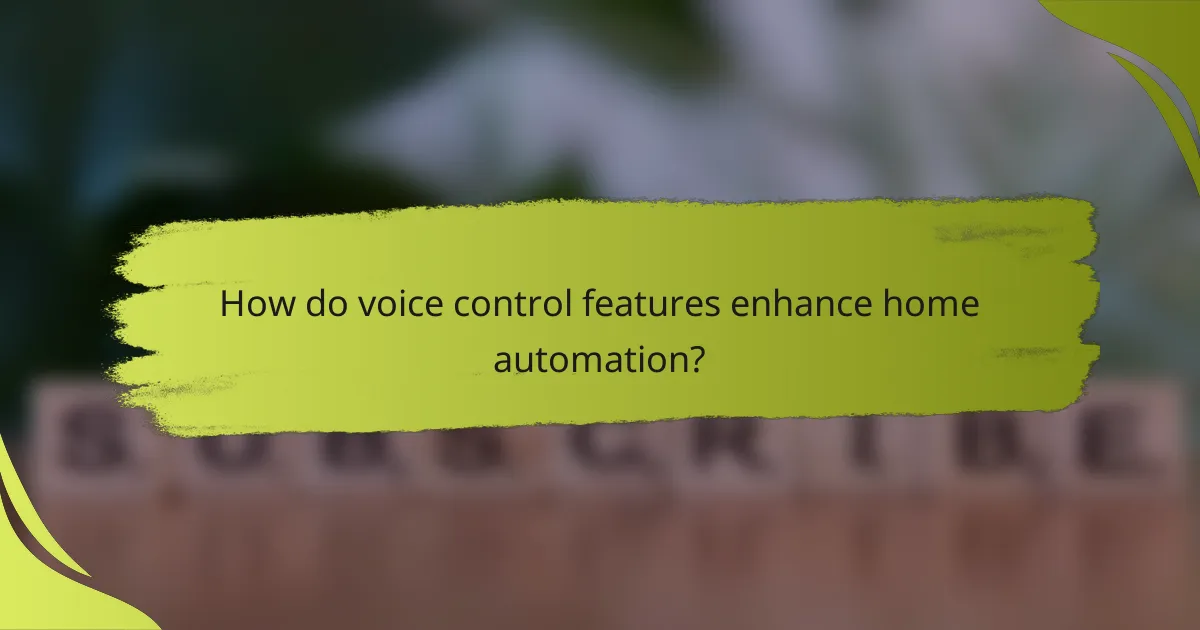
How do voice control features enhance home automation?
Voice control features significantly enhance home automation by allowing users to manage devices through spoken commands. This technology simplifies interactions, making it easier to control various systems without needing physical interfaces.
Improved accessibility
Voice control improves accessibility for individuals with mobility challenges or disabilities. By enabling hands-free operation, users can easily adjust lighting, temperature, or security systems without needing to physically interact with devices.
For example, someone with limited mobility can use voice commands to lock doors or turn on appliances, enhancing their independence and comfort at home.
Hands-free operation
Hands-free operation is a key benefit of voice control in home automation. Users can perform tasks while multitasking, such as cooking or cleaning, without interrupting their activities. This convenience allows for a more seamless daily routine.
Common commands include adjusting the thermostat, playing music, or turning off lights, all of which can be executed simply by speaking, making life easier and more efficient.
Energy efficiency
Voice control can contribute to energy efficiency by enabling users to manage their home systems more effectively. For instance, users can quickly turn off lights or adjust heating when they leave a room, reducing unnecessary energy consumption.
Integrating voice control with smart energy monitoring systems can provide insights into usage patterns, helping homeowners make informed decisions about energy-saving practices. This can lead to lower utility bills over time.

What are the best home automation systems with voice control in India?
The best home automation systems with voice control in India include devices that seamlessly integrate with smart home ecosystems, allowing users to manage their home environment through voice commands. Popular options like Amazon Echo, Google Nest Hub, and Apple HomePod offer unique features and compatibility, making them suitable for various preferences and needs.
Amazon Echo with Alexa
The Amazon Echo, powered by Alexa, is a leading choice for voice-controlled home automation in India. It allows users to control compatible smart devices, play music, set reminders, and access information using simple voice commands. With a range of models available, including the Echo Dot and Echo Show, users can select a device that fits their space and budget.
When setting up the Amazon Echo, ensure that your smart devices are compatible with Alexa for optimal performance. Additionally, consider enabling routines, which allow you to automate multiple actions with a single command, enhancing convenience.
Google Nest Hub
The Google Nest Hub offers a user-friendly interface combined with Google Assistant’s powerful voice recognition capabilities. This device not only controls smart home devices but also provides visual feedback, such as displaying recipes, photos, and calendar events. Its integration with Google services makes it a great option for users already invested in the Google ecosystem.
To maximize the Nest Hub’s potential, link it with various smart devices and explore its voice commands for tasks like adjusting lighting or controlling thermostats. The device’s touchscreen can also be useful for managing settings and viewing information at a glance.
Apple HomePod
The Apple HomePod is designed for users who prioritize high-quality audio and seamless integration with Apple products. Utilizing Siri for voice control, it allows users to manage smart home devices, play music, and access information through voice commands. Its compatibility with Apple HomeKit enhances security and privacy for users concerned about data protection.
When using the HomePod, ensure your smart devices are compatible with HomeKit for a smooth experience. Take advantage of Siri Shortcuts to create personalized voice commands that streamline your daily routines, making home automation even more efficient.
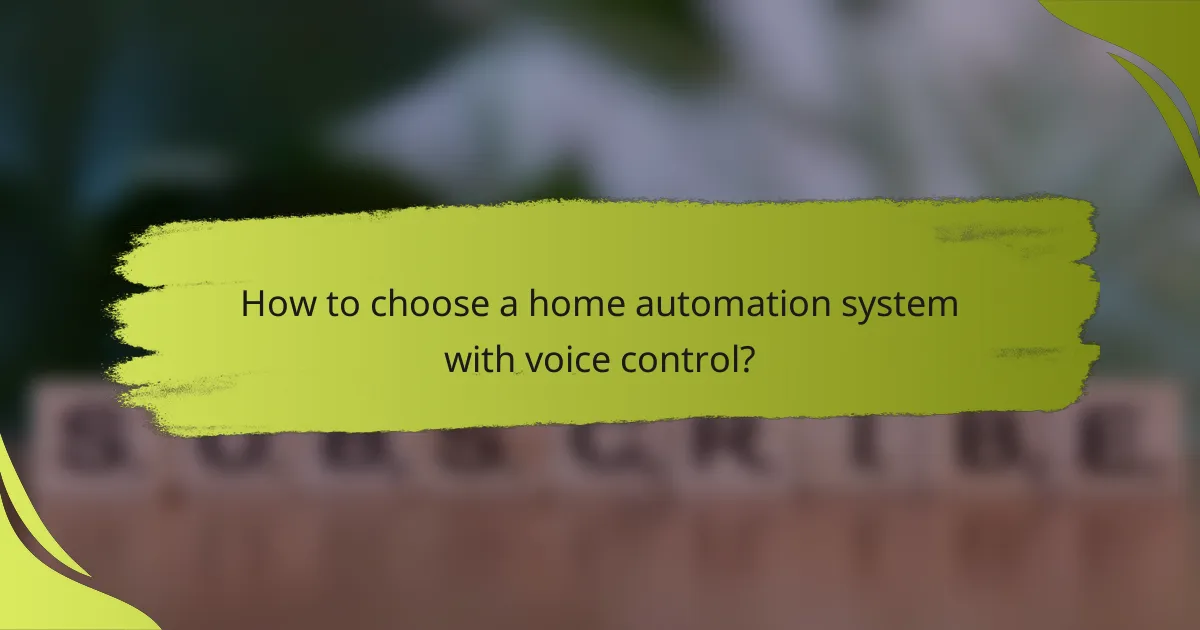
How to choose a home automation system with voice control?
Choosing a home automation system with voice control involves assessing compatibility, user interface, and security features. Prioritize systems that seamlessly integrate with your existing devices and offer an intuitive experience while ensuring robust security measures.
Assess compatibility with existing devices
Compatibility is crucial when selecting a home automation system. Ensure that the system can connect with your current devices, such as smart lights, thermostats, and security cameras. Look for systems that support popular protocols like Zigbee, Z-Wave, or Wi-Fi to maximize integration.
Check the manufacturer’s website for a list of compatible devices. Some systems may only work with specific brands or models, which can limit your options. A versatile system will allow you to expand your smart home setup without needing to replace existing devices.
Evaluate user interface and ease of use
An intuitive user interface enhances the experience of using a voice-controlled home automation system. Look for systems that offer a straightforward app or web interface, allowing easy control of all connected devices. Voice commands should be simple and responsive, making daily interactions seamless.
Consider systems with customizable settings and routines. This feature enables you to tailor the automation to your lifestyle, such as setting specific commands for different times of the day. User reviews can provide insights into the ease of use and overall satisfaction with the interface.
Consider security features
Security is a vital aspect of any home automation system, especially those with voice control. Look for systems that offer end-to-end encryption, secure cloud storage, and two-factor authentication to protect your data and privacy. Regular software updates are also essential to address potential vulnerabilities.
Be cautious of systems that require excessive personal information or have a history of security breaches. Research the manufacturer’s reputation for security and read user feedback to ensure you choose a reliable option that prioritizes your safety.
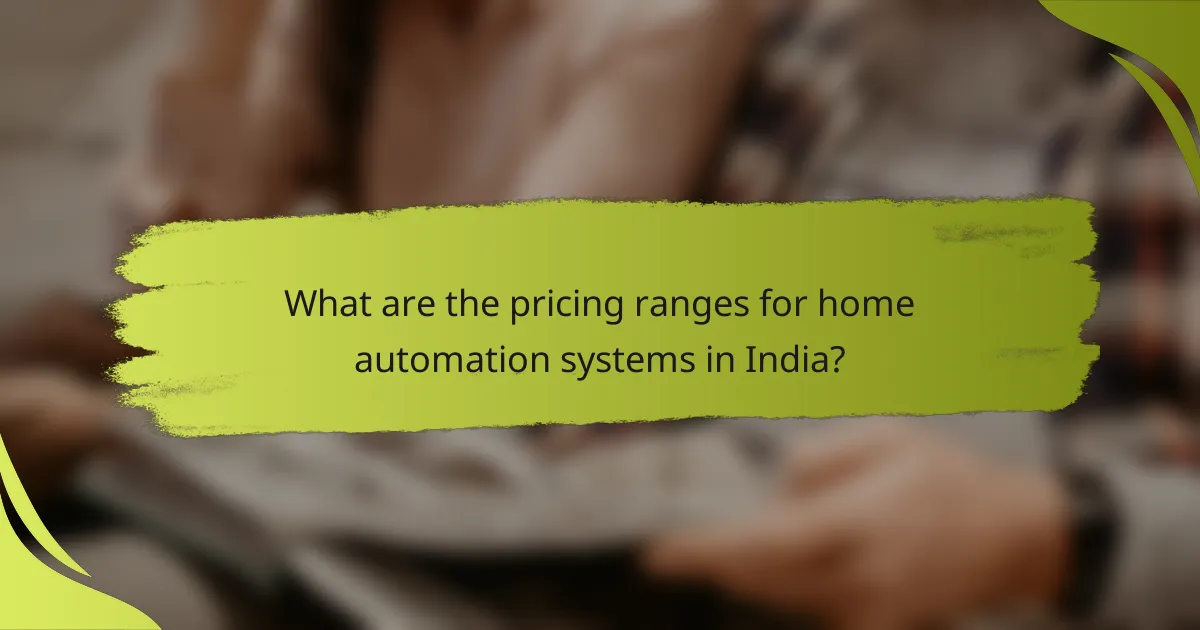
What are the pricing ranges for home automation systems in India?
Home automation systems in India typically range from affordable entry-level setups to premium high-end solutions. Prices can vary widely based on features, brand, and complexity, generally starting from around INR 10,000 and going up to several lakhs.
Entry-level systems
Entry-level home automation systems are designed for budget-conscious consumers looking to enhance convenience without significant investment. These systems usually start around INR 10,000 and can include basic features like smart lighting and simple security cameras.
Common products in this category often integrate with existing devices and may require minimal installation. Users should consider compatibility with their current home setup and ease of use, as many entry-level systems offer user-friendly mobile apps for control.
Mid-range options
Mid-range home automation systems typically range from INR 30,000 to INR 1,00,000 and offer more advanced features such as integrated voice control, smart thermostats, and enhanced security options. These systems often allow for greater customization and can manage multiple devices simultaneously.
When selecting a mid-range system, look for compatibility with various smart home devices and platforms, as well as the ability to create automation routines. This flexibility can significantly enhance the overall user experience and efficiency of the system.
High-end solutions
High-end home automation solutions can exceed INR 1,00,000 and offer comprehensive control over nearly every aspect of a home, including lighting, security, climate, and entertainment systems. These systems often feature advanced technologies like AI integration and can be tailored to meet specific user needs.
Investing in a high-end system often involves professional installation and ongoing support, ensuring optimal performance and integration. Buyers should consider long-term benefits, such as energy savings and increased property value, when evaluating these premium options.
